Complete Guide to Golden Spike National Historical Park in Utah including things to do, history, camping and lodging near the park, how to get to the park, and more!
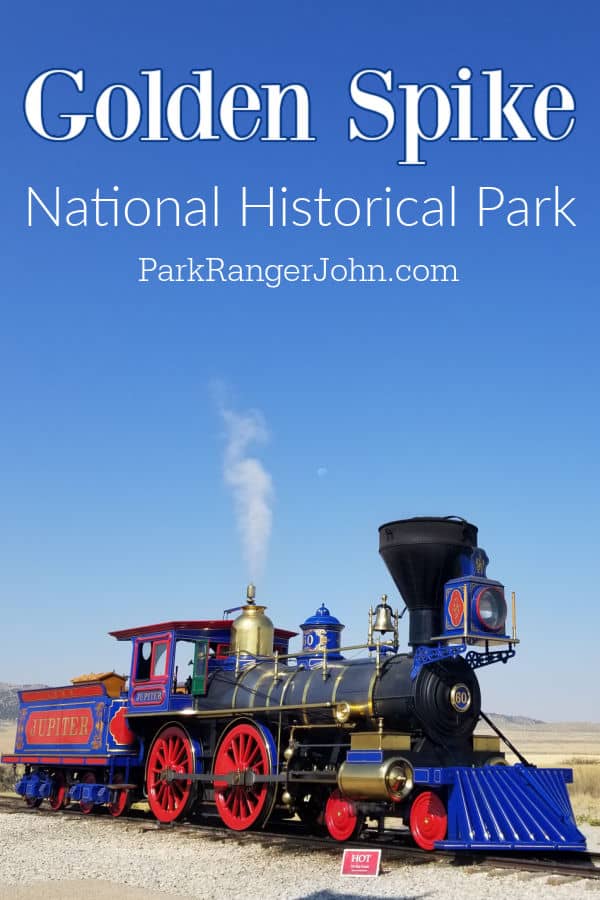
Golden Spike National Historical Park
You will want to give yourself plenty of time to explore Golden Spike NHS! Our biggest tip is to schedule your visit around the locomotive engines arriving or leaving the visitor center.
We were in awe as the Jupiter Locomotive and 119 Locomotive arrived at the park. It is hard to describe the feeling of hearing the locomotives arriving.
The Park Rangers do an amazing job detailing what it took to build the historic transcontinental railroad that was completed at the park site.
One cool thing we learned is the paintings on the 119 Locomotive were done by one of Disney's first animators.
The Replica Jupiter and 119 Locomotives are amazing and you will be amazed at the details that are on display.
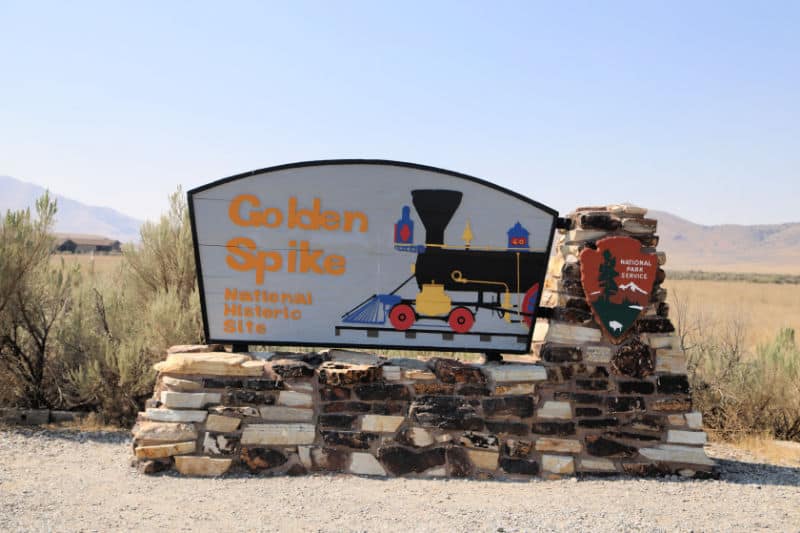
About Golden Spike National Historical Park
On May 10, 1869, the celebratory Golden Spike was driven into the ground to celebrate the marriage of rails for the first transcontinental railway at Promontory Summit, Utah Territory!
This event would change the future of the United States! Golden Spike National Historic Site celebrates this monumental event and showcases the work that went into making it happen.
The transcontinental railroad drastically shortened the time it took for people to travel from the east coast to California allowing for rapid expansion across the country.
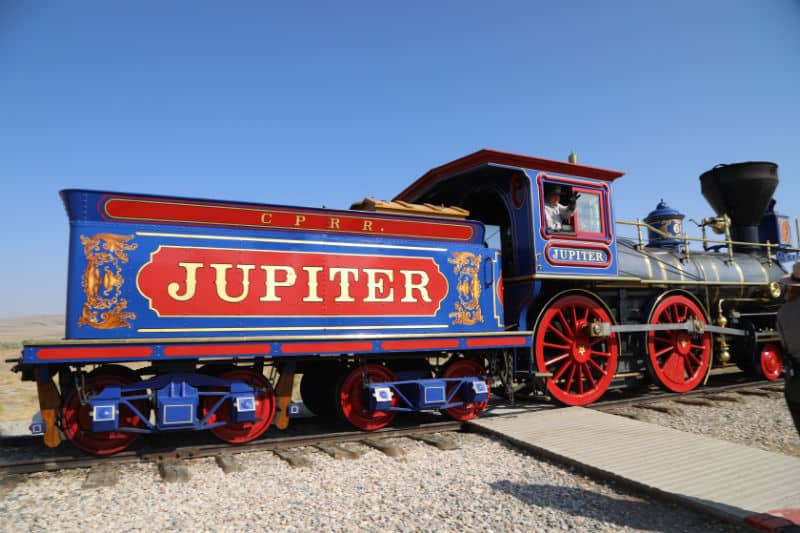
Is Golden Spike National Historical Park worth visiting?
Yes! Yes! Yes!
We were not sure what to expect when we first visited Golden Spike NHP! The park quickly became one of our favorite parks.
Seeing the trains pull down the rails and hearing about the history of the park is truly amazing.
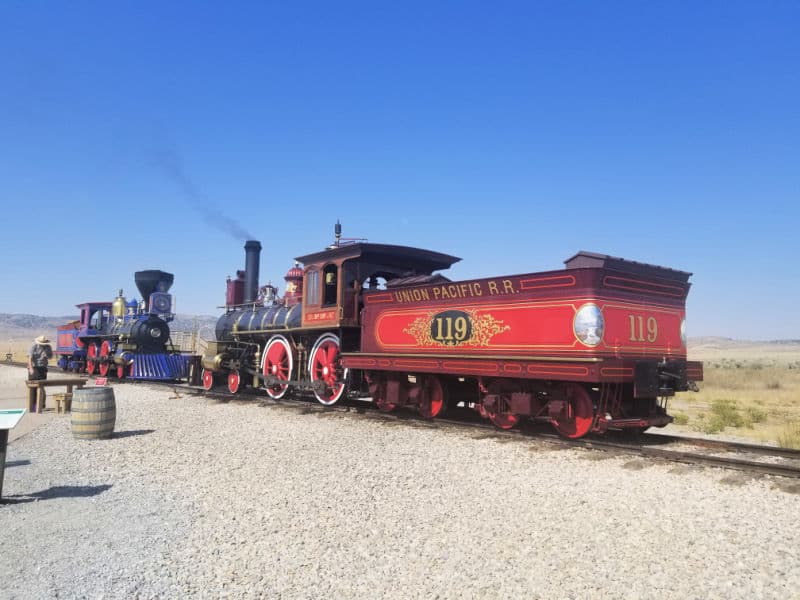
History of Golden Spike National Historical Park
Golden Spike National Historical Park is located in Promontory Summit, Utah, the nearest town being Corrine. It is approximately 60 miles northwest of Salt Lake City. The site commemorates the completion of America’s first Transcontinental Railroad on May 10, 1869.
In 1847, an idea to build a great railroad from the lakes of Michigan to the Pacific Ocean was presented to Congress. Between 1853 and 1855, with the blessing from Congress, surveys were done and routes through the west were suggested.
In the years that followed, it was agreed that the Transcontinental Railroad would be completed by building a route between Sacramento, California and Omaha, Nebraska.
A few years later, President Abraham Lincoln approved the Pacific Railroad Act.
This stated that the Central Pacific Railroad Company would begin building in Sacramento and travel east, and the Union Pacific Company would begin near the Iowa-Nebraska border and travel west.
The two companies would meet in the middle and would receive $48,000 in government bonds for every mile of track completed. This, ultimately, began the competition between the two companies. The project began in 1863, in the middle of America’s Civil War.
Little was completed in the east at first, but as the Civil War ended, a Union General named Greenville Dodge took over as Chief Engineer and the Union Pacific got moving in 1886.
As one company built west and one east, each side encountered major threats.
The Union Pacific suffered numerous bloody attacks by Native American tribes along the route.
The Native Americans saw the project as the white man’s “big iron horse” meant to destroy their homeland.
The greatest challenge for the Central Pacific was the massive Sierra Nevada mountain range. Their railroad route planned to go straight through sections of the mountain.
Threats of injury or death due to severe winter storms in higher elevations and rock falls. Gunpowder and nitroglycerine were used to blast tunnels through the mountains. Danger was imminent in many areas.
The workers who faced these dangers varied largely between the companies as well.
In 1865, the Central Pacific began hiring Chinese laborers as it was hard to keep steady workers due to the difficulty of the job.
Due to the Gold Rush, thousands of Chinese immigrants had flocked to the west coast and once realizing they were not striking it rich, needed a way to earn a living. By 1867, over 14,000 Chinese were working for the Central Pacific. These laborers proved to be strong, diligent workers despite the poor pay and discrimination they received.
To the east, the Union Pacific was hard at work among threats of Native Americans. This company was comprised mainly of Irish immigrants and Civil War veterans.
As the war ended in 1865, many soldiers returned to a different world and needed employment. Soon, another challenge sprang up along the Union Pacific route – saloons and gambling houses.
Businesses knew the railroad workers would welcome an outlet from the hard labor and workers were often spending all of their money and drinking more than was preferred at night.
As the summer of 1867 arrived, the Union Pacific, having laid tracks over the flat central plains, had laid four times more tracks than the Central Pacific.
Once the Central Pacific finally broke through the Sierra Nevadas, the race to cover ground was on.
By early 1969, President Ulysses S. Grant announced that the two companies needed to mutually decide upon a meeting point. It was agreed that Promontory Point would be the spot where the two railroads would come together to link the tracks.
This spot was just north of the Great Salt Lake. The meeting point meant that 690 miles of track would be completed by the Central Pacific, and 1,086 miles by the Union Pacific.
In the spring of 1969, the companies were ready to solidify the link between the east and the west. An event referred to as the “Golden Spike Ceremony” was scheduled for May 10th.
A contractor from San Francisco gifted a symbolic 17.6 karat golden spike to complete the transcontinental railroad.
After the Golden Spike was hit by various contractors and workers, it was replaced with traditional iron spikes.
An iconic photo was taken that day and is forever known to show a defining moment in American history.
The photo was commonly known as the “Champagne Photo” but formally titled “East and West Shaking Hands at the Laying of the Last Rail.” An engine from each company was brought near the point and the two were positioned to nearly touching.
Photographer Andrew J. Russell captured Central Pacific’s Chief Engineer Samuel S. Montague and the Union’s General Greenville M. Dodge shaking hands at the point while workers gathered together in front of and on top of the engines to celebrate.
One worker can be seen standing on the engine and raising a bottle of champagne in the air.
Telegraphs around the country immediately sent out the famous message at 12:47 PM letting America know the historic project was complete. The message read simply: D-O-N-E.
The completion of the Transcontinental Railroad had many effects on America. Travel from coast to coast was substantially faster and western goods were now able to be shipped east.
Cattle trails in the west and southwest led droves of cattle to railways on the plains and shipped them east to market. This supplied beef to parts of the county that previously had very little.
Westward Expansion grew rapidly, and the rails opened up new land to citizens, leading to increasing tensions with Native Americans trying to defend their generational lands.
This project truly led to one of the most substantial changes in U.S. history.
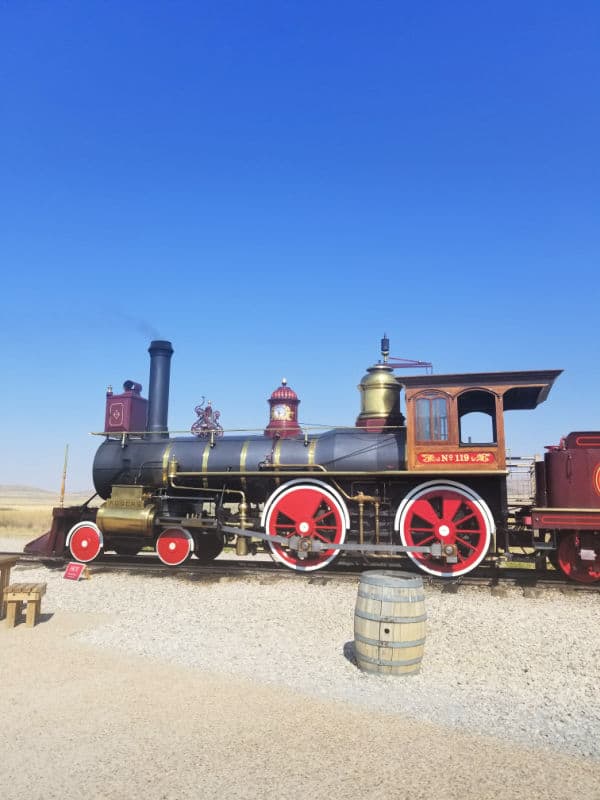
Things to know before your visit to Golden Spike National Historical Park
Entrance fee
7-day single-vehicle park pass - $20
7-day individual park pass - $10
7-day motorcycle park pass - $15
Learn more about National Park Passes for parks that have an entrance fee.
$80.00 - For the America the Beautiful/National Park Pass. The pass covers entrance fees to all US National Park Sites and over 2,000 Federal Recreation Fee Sites for an entire year and covers everyone in the car for per-vehicle sites and up to 4 adults for per-person sites.

Buy your pass at this link, and REI will donate 10% of pass proceeds to the National Forest Foundation, National Park Foundation, and the U.S. Endowment for Forestry & Communities.
National Park Free Entrance Days -Mark your calendars with the five free entrance days the National Park Service offers annually.
Time Zone
Golden Spike National Historic Site is in the Mountain Time Zone and honors Daylight Savings Time.
Pets
Pets must be kept on a leash while at the park. They are not allowed in the visitor center.
Be prepared to maintain control of your pet when the replica locomotives are moving around and making a lot of noise.
Cell Service
Cell service is only available near the visitor center.
Park Hours
Visitor Center - 9 am to 5 pm daily
The visitor center is closed on Thanksgiving, Christmas, and New Years Days
Call the visitor center at 435-471-2209 x429 for operation schedule and tour availability.
Wi-Fi
Public Wi-Fi is not available.
Insect Repellent
Insect repellent is always a great idea when outdoors, especially if you are around any body of water.
We use Permethrin Spray on our clothes before our park trips.
Water Bottle
Make sure to bring your own water bottle and plenty of water with you. Plastic water bottles are not sold in the park.
Parking
There is a large parking lot in front of the visitor center.
Food/Restaurants
There are no restaurants within the park. The visitor center had a few snacks available during our visit.
Gas
There are no gas stations within the park. The closest gas station is more than 27 miles from the park in Corrine, Utah.
Drones
Drones are not permitted within National Park Sites.
National Park Passport Stamps
National Park Passport stamps can be found in the visitor center.
Golden Spike NHS is part of the 1994 Passport Stamp Set.
We like to use these circle stickers for park stamps so we don't have to bring our passport book with us on every trip.
The National Park Passport Book program is a great way to document all of the parks you have visitied.
You can get Passport Stickers and Annual Stamp Sets to help enhance your Passport Book.
Electric Vehicle Charging
The closest EV Charging Station is in Salt Lake City, Utah.
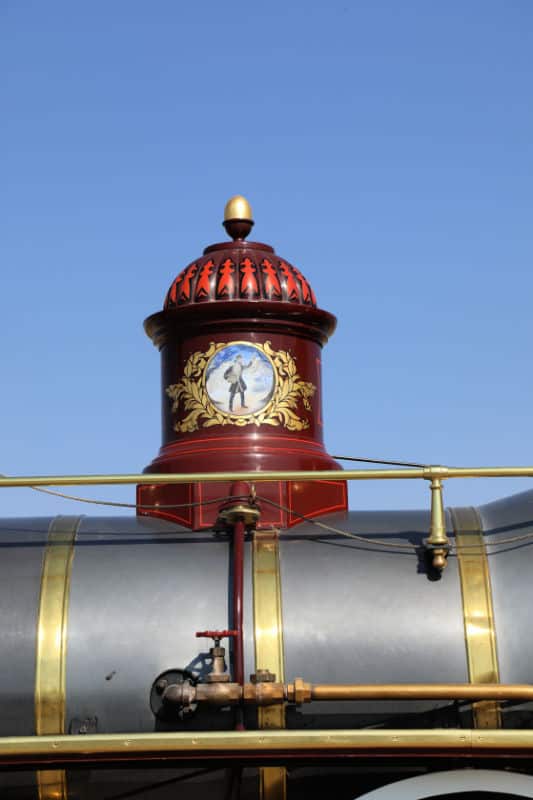
Details about Golden Spike National Historical Park
Size - 2,735 acres
Check out how the park compares to other National Parks by Size.
Date Established
On April 2, 1957, the park was established as Golden Spike National Historic Site.
On March 12, 2019, The park was re-designated as a National Historical Park.
Visitation
In 2021, Golden Spike NHP had 52,910 park visitors.
In 2020, Golden Spike NHP had 53,106 park visitors.
In 2019, Golden Spike NHP had 108,154 park visitors.
Learn more about the most visited and least visited National Parks in the US
National Park Address
6200 North 22300 West
Promontory Summit, UT 84307
GPS Coordinates Golden Spike National Historic Site is located at latitude-longitude coordinates of N 41.62048 and W -112.54747.
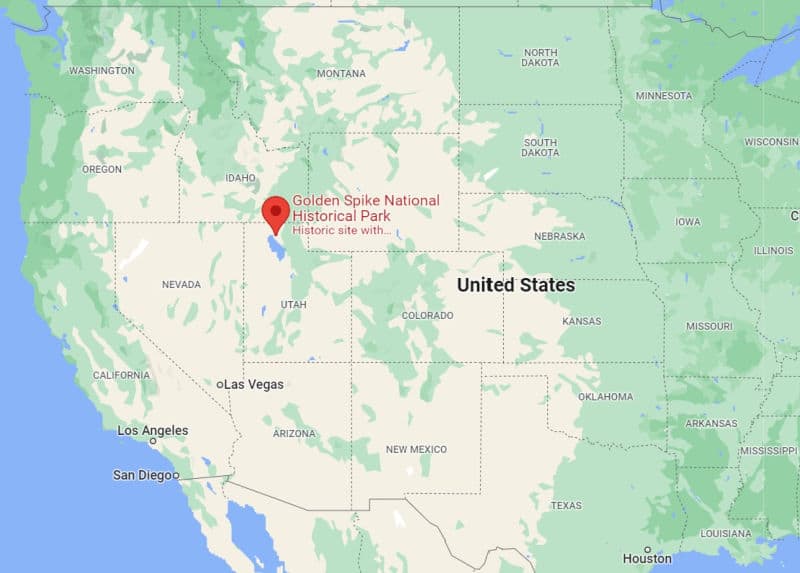
Where is Golden Spike National Historical Park?
Golden Spike NHP is located in northern Utah.
Estimated distance from major cities nearby
- Brigham City, UT - 32 miles
- North Ogden, UT - 48 miles
- Logan, UT - 51 miles
- Salt Lake City, UT - 87 miles
- Park City, UT - 117 miles
- Boise, ID - 273 miles
- Las Vegas, NV - 506 miles
- Reno, NV - 534 miles
- Denver, CO - 563 miles
- Colorado Springs, CO - 630 miles
- Fresno, CA - 832 miles
- San Francisco, CA - 751 miles
Estimated Distance from nearby National Park
Grand Teton National Park - 237 miles
Yellowstone National Park - 274 miles
Great Basin National Park - 325 miles
Arches National Park - 323 miles
Capitol Reef National Park - 298 miles
Zion National Park - 393 miles
Where is the National Park Visitor Center?
The visitor center is the first place you will visit. It is off the main road into the park.
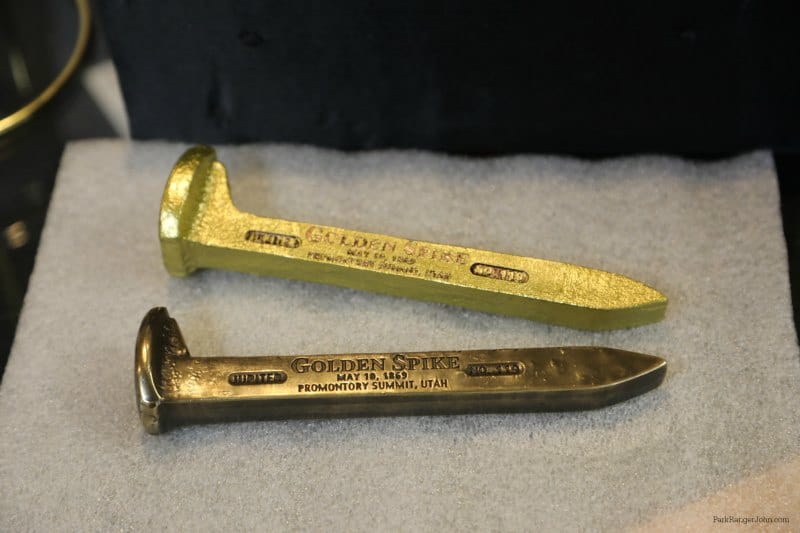
Getting to Golden Spike National Historical Park
Closest Airports
Ogden Hinckley Airport (OGD)
International Airports
Salt Lake City International Airport (SLC)
Driving Directions
From Interstate 15 headed north, take exit 365 via Utah State Highway 13/83; approximately 32 miles west of Brigham City.
From Interstate 15 headed south, take exit 40 via Utah State Highway 102 to highway 83; approximately 32 miles west of Tremonton.
From Interstate 84 headed south, take exit 26 via Utah State Highway 83; approximately 22 miles from Howell.
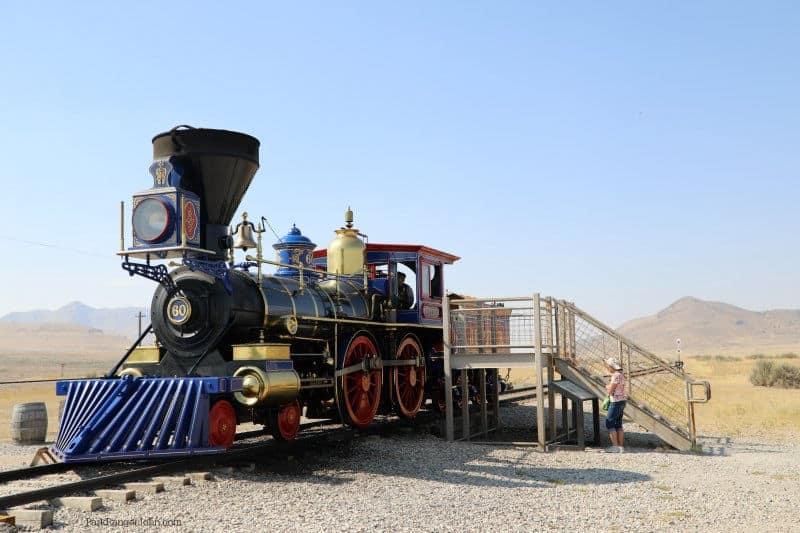
Best time to visit Golden Spike National Historical Park
The best time to visit the park is spring through fall. The weather may be hot in the middle of the summer but it should be gorgeous out.
Weather and Seasons
The park experiences hot dry summers and snowy cold winters.
The hottest weather is from June 11 to September 14th with an average daily temperature above 79 degrees.
The coldest weather is from November 23 to February 25th with an average daily temperature below 44 degrees.
May averages the most rain with 1.7 inches. The most snow falls in January with 3.7 inches.
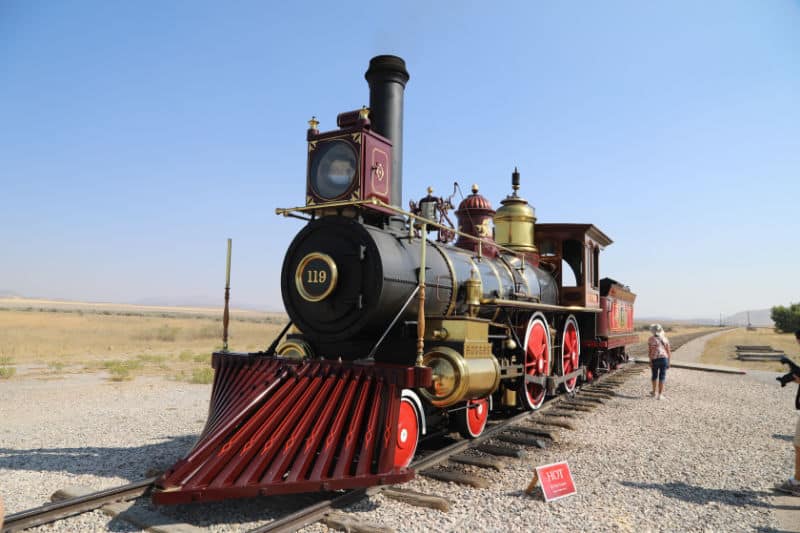
Best Things to do in Golden Spike National Historical Park
We suggest planning a minimum of half a day at the park in order to see the trains and explore the visitor center.
We ended up spending longer than we had planned at the park because we were so immersed in all of the things to do and see.
Visitor Center
The Golden Spike Visitor Center is filled with a wealth of information! You will want to give yourself time to watch one of the movies, check out the displays, and shop in the store.
If you are a train buff you will need to be prepared because they have a lot of really cool train items in the gift store!!! Leave room in your suitcase if you collect train memorabilia or fun train items.

Junior Ranger Program
The Golden Spike Junior Ranger program is a great way to learn more about the park and the importance of the train rails joining together.
The program will take an average of 30 to 90 minutes to complete depending on the age of the participant.
The answers can be found in the visitor center displays and also in the park brochure.
Watch the trains
This was the highlight of our visit to Golden Spike NHS!!!! You want to make sure that you visit the park in the morning when the locomotives arrive or later in the afternoon when they depart.
It is beyond cool to hear them running!
I didn't realize before this demonstration how much the rails vibrate and you can hear the locomotives coming towards you.
Demonstrations run daily from May 1st through mid-October, except on boiler wash days. Demonstration runs start at 10:00 am with the arrival of the Jupiter locomotive followed by the arrival of the No. 119 locomotive at 10:30 am.
Both locomotives do a demonstration run at 1:00 pm and then depart for the Engine House at 4:00 pm (No. 119) and 4:30 pm (Jupiter).
There are 8 days during the summer that the boilers are washed so make sure and confirm the locomotives are running on the day you plan to visit.
Re-enactment of the driving of the last spike
From Memorial Day to Labor Day a dedicated team of volunteers performs the reenactment of the Driving of the Last Spike Site ceremony at the park.
Summer reenactments are on Saturdays and Holidays and take place at 11 am and 1 pm (following 1:00 pm Locomotive Demonstration).
Tour the Engine House, Home to the Jupiter and No. 119
From mid-October to late April, the Jupiter and No. 119 locomotives are maintained in the Engine House.
Tours are typically offered Saturday and Sunday from mid-October until late April.
Auto Tours
You can drive the transcontinental railroad grade and see just what workers were building in 1869. The East Auto Tour is two miles long and allows visitors to see cuts, fills, and culverts.
The West Auto Tour is seven miles long and is home to the "10 Miles of Track, Laid in one Day" sign where the Central Pacific Railroad built 10 miles and 56 feet of track on April 28th, 1869. Make sure and check with the visitor center for current road conditions.
Auto Tours are not approved for RV's or vehicles pulling a trailer.
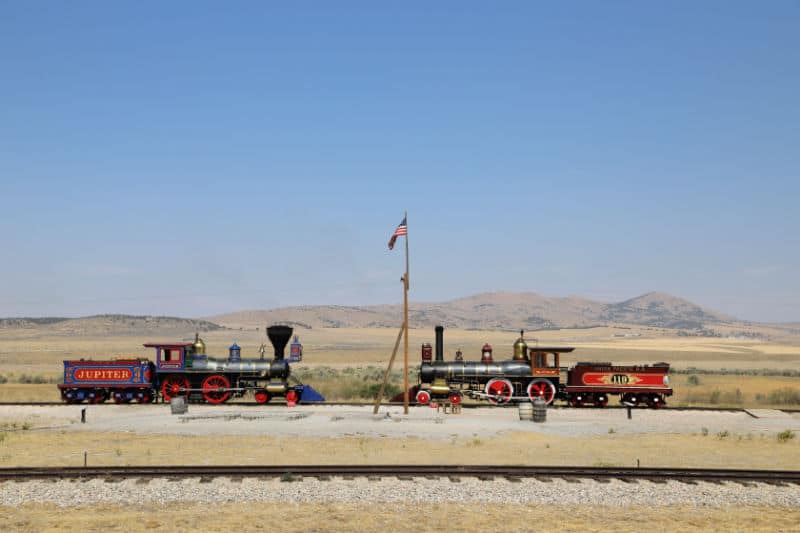
Hiking in Golden Spike National Historical Park
Always carry the 10 essentials for outdoor survival when exploring.
Big Fill Loop Trail
Distance - 1.5 mile trail
The Big Fill Loop Trail showcases the building techniques used by the railroads. Make sure and be prepared for the sun and heat on this hike. There is no shade or water available on the trail.
Ranger-led hikes are offered on this trail on Sunday afternoons and sometimes Friday afternoons. Call the visitor center at 435-471-2209 ext. 429 to inquire about availability.
How to beat the crowds in Golden Spike National Historical Park?
We found the crowds easy to maneuver through,, There is quite a bit of space outside during the train demonstrations.
Where to stay when visiting Golden Spike National Historical Park
There are no National Park Lodges within the park. The closest lodging can be found in Tremonton, Bringham City, and then in Ogden and Logan.
Hampton Inn Tremonton - Take advantage of free to-go breakfast, shopping on site, and dry cleaning/laundry services at Hampton Inn Tremonton. Stay connected with free in-room Wi-Fi, and guests can find other amenities such as a gym and a business center.
Holiday Inn Express & Suites Brigham City - Take advantage of free to-go breakfast, a firepit, and laundry facilities at Holiday Inn Express & Suites Brigham City - North Utah, an IHG Hotel. Free in-room Wi-Fi is available to all guests, along with a 24-hour gym and a 24-hour business center.
Days Inn by Wyndham Brigham City - You can look forward to free to-go breakfast, dry cleaning/laundry services, and a fireplace in the lobby at Days Inn by Wyndham Brigham City. For some rest and relaxation, visit the hot tub. Free in-room Wi-Fi is available to all guests, along with a gym and a business center.
Hampton Inn Brigham City - You can look forward to free continental breakfast, golfing on site, and dry cleaning/laundry services at Hampton Inn Brigham City. In addition to a gym and a 24-hour business center, guests can connect to free in-room Wi-Fi.
Best Western Brigham City Inn & Suites - At Best Western Brigham City Inn & Suites, you can look forward to a free breakfast buffet, a coffee shop/café, and dry cleaning/laundry services. For some rest and relaxation, visit the hot tub. Free in-room Wi-Fi is available to all guests, along with a 24-hour gym and a 24-hour business center.
Click on the map below to see additional hotels and vacation rentals near the park.
Camping
The park does not have a campground.
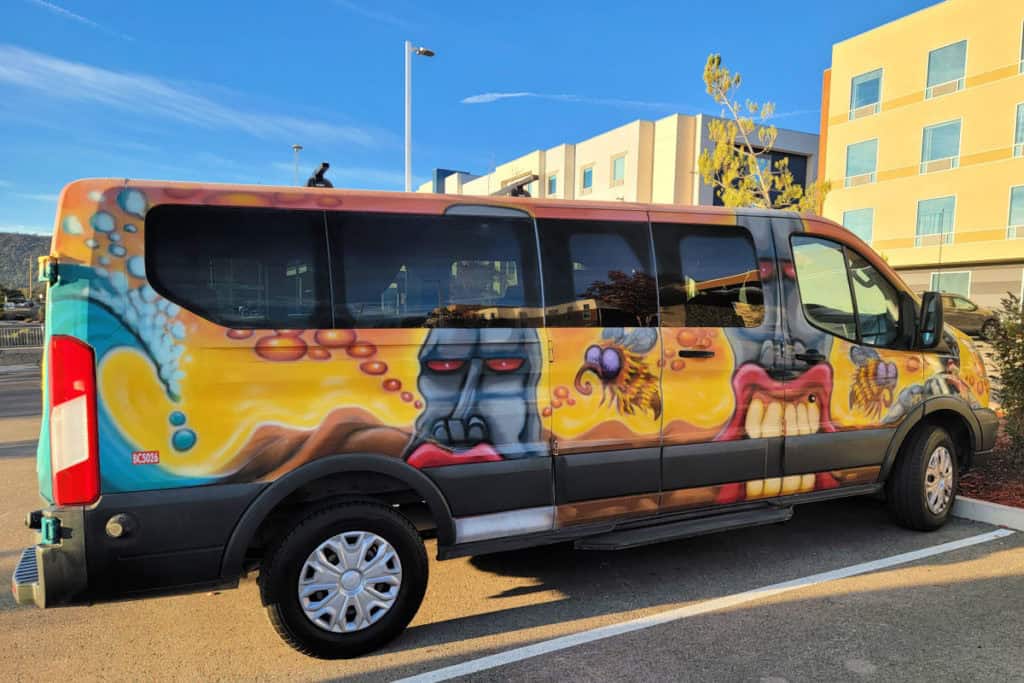
For a fun adventure check out Escape Campervans. These campervans have built in beds, kitchen area with refrigerators, and more. You can have them fully set up with kitchen supplies, bedding, and other fun extras. They are painted with epic designs you can't miss!
Escape Campervans has offices in Vancouver, Seattle, Portland, San Francisco, Las Vegas, Los Angeles, Phoenix, Salt Lake City, Denver, New York, and Orlando
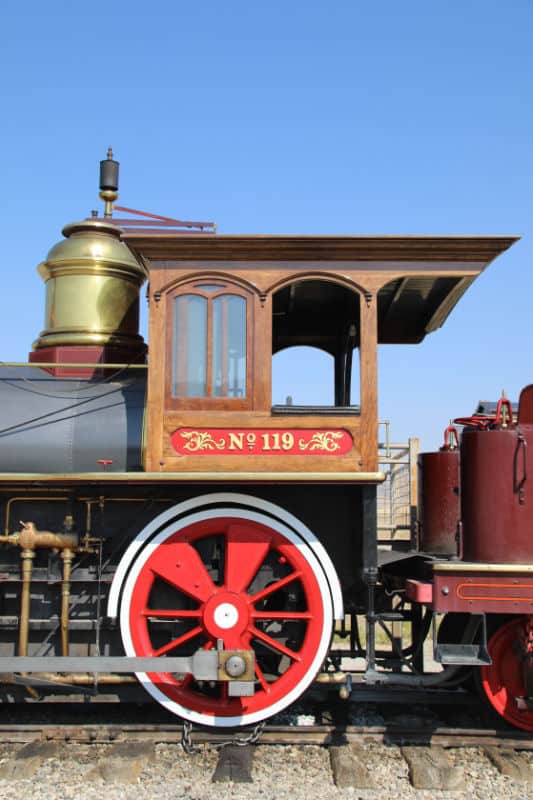
Parks Near Golden Spike National Historical Park
Minidoka National Historic Site - 152 miles
City of Rocks National Reserve - 97 miles
Craters of the Moon National Monument and Preserve - 227 miles
Fossil Butte National Monument (Wyoming) - 135 miles
Timpanogos Cave National Monument - 119 miles
Check out all of the National Parks in Utah along with neighboring National Parks in Arizona, National Parks in Colorado, National Parks in Idaho, Nevada National Parks, New Mexico National Parks, and Wyoming National Parks
Make sure to check out the Utah State parks nearby including Willard Bay State Park, Antelope Island State Park, Great Salt lake State Park, and East Canyon State Park.
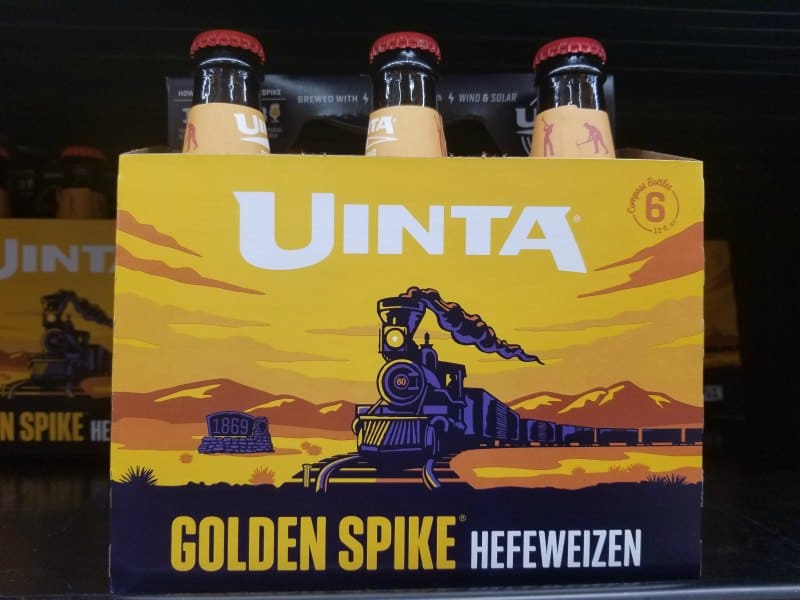
Keep an eye out for Unita Golden Spike Hefeweizen Beer while in Utah. This is a great National Park Beer!
Make sure to follow Park Ranger John on Facebook, Instagram, Pinterest, and TikTok

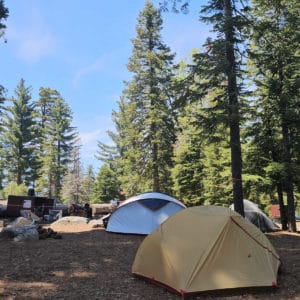
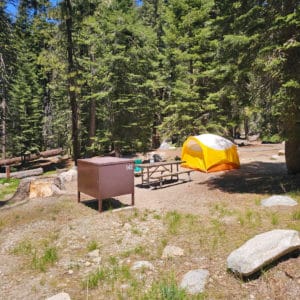
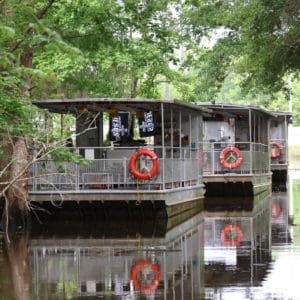
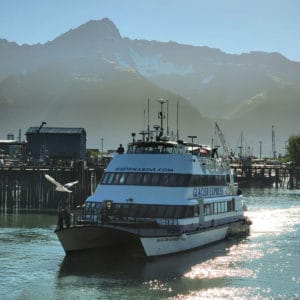
Leave a Reply